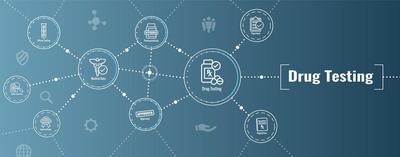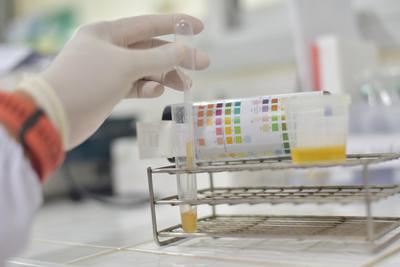What Are Standard Drug Testing Cutoff Levels?
When conducting employment drug testing, it's important for employers to recognize there are cutoff levels that laboratories will use to measure employee test results. Drug test cutoff levels are set measurement thresholds that determine if a test specimen is positive or negative for a specific controlled substance.
Whether you're an employer or employee, you may be curious as to how these employee drug testing cutoff levels can impact your final results. To learn more about the components of standard drug test cutoff levels and the specific levels you should refer to, read more below.
Listen to article

Understanding Drug Test Screening Level vs. Confirmation Level
Laboratories typically follow a two-part testing process for employment drug testing. The first part consists of analyzing only a portion of the specimen, whether it's a urine drug test or hair follicle drug test, for an initial drug screening. An initial test identifies and removes negative specimens from additional consideration in the event a controlled substance has been detected.
If the initial drug screening does detect a controlled substance that sits at or above its specific cutoff level, then a second portion of the specimen must be sent for a confirmatory test. A confirmatory test uses a more robust method, such as chromatography-mass spectrometry, to accurately identify the drug metabolite and its present amount in the specimen.
If a drug metabolite amount measures at or above that substance's specific cutoff level, the employment drug testing laboratory will report the result as positive. Cutoff levels are established to provide testing subjects the benefit of the doubt in the event small amounts of drug metabolites are detected in their system due to circumstances such as medications or secondhand smoke.
Comprehending ng/mL and pg/mg Drug Screening Measurements
With standard drug tests, the form of measurement used to identify the concentration level of a drug metabolite depends on the type of specimen being used. When assessing drug metabolite measurements, it's important to first refer to the drug cutoff levels specifically assigned to the specimen type being tested.
For oral fluid or urine drug tests, cutoff levels are expressed using nanograms (ng) per milliliter (mL). However, if an employer requests a hair follicle drug test, the concentration level of a drug metabolite will instead be displayed as picograms (pg) per milligram (mg).
Industry Standard Cut-off Levels for Drug Tests
When conducting employee drug testing, certain industries will require employers to follow regulatory requirements for the type of testing specimen and its accompanying cutoff levels. Using pre-established drug cutoff levels as a baseline, the laboratory can determine if a subject is positive or negative for various controlled substances.
Federal/Department of Transportation (DOT) Standard Drug Test Cutoff Levels
For federally-regulated sectors, such as the Department of Transportation, employers are required to comply with set employee drug testing procedures. This includes following established drug metabolite concentration cut-off levels when conducting testing.
Federally-regulated sectors typically follow a 5-panel drug test regimen, which uses urine specimens to screen for five of the most commonly used substances, as well as two common derivatives (seven total substances). Federally-regulated departments should refer to these cutoff levels established by the U.S. Department of Health and Human Services:
| Drug Type | Initial Test Cutoff Level - Confirmatory Test Cutoff Level |
| Marijuana metabolites | 50 ng/mL - 15 ng/mL |
| Cocaine metabolites | 150 ng/mL - 100 ng/mL |
| Opiate metabolites | 2000 ng/mL - 2000 ng/mL |
| Phencyclidine (PCP) | 25 ng/mL - 25 ng/mL |
| 6-Acetylmorphine | 10ng/mL - 10ng/mL |
| MDMA - 500 ng/mL | 500 ng/mL - 250 ng/mL |
| Amphetamines | 500 ng/mL - 250 ng/mL |
On the initial drug test, if a specimen tests positive for any of the above substances but the amount does not surpass the initial cutoff level, the test will be declared negative. If the amount does surpass the initial cutoff level, then a secondary test will be conducted, where if that amount surpasses confirmatory test cutoff levels, it will be reported as positive.
Non-Federally Regulated Standard Drug Test Cutoff Levels
For employers who are not federally regulated, there are no set drug test cutoff level requirements that must be followed. While most federal organizations follow the use of a 5-panel drug test, private employers can request upwards of a 10- or 12-panel drug test if state law and/or company policy allows.
For the commonly selected urine 5-panel drug test, many will follow the drug testing cutoff levels established by the federal regulations. If an employer decides to increase their testing efforts to, let's say a 10 -panel urine drug test, commonly screened substances found in drug tests and accompanying cutoff levels can include:
| Drug Type | Initial Test Cutoff Level - Confirmatory Test Cutoff Level |
| Marijuana metabolites | 50 ng/mL - 15 ng/mL |
| Cocaine metabolites | 150 ng/mL - 100 ng/mL |
| Opiate metabolites | 2000 ng/mL - 2000 ng/mL |
| Phencyclidine (PCP) | 25 ng/mL - 25 ng/mL |
| Semi-Synthetic Opiates | 300 ng/mL - 100 ng/mL |
| Barbiturates | 300 ng/mL - 300 ng/mL |
| Amphetamines | 500 ng/mL - 250 ng/mL |
| Benzodiazepines | 300 ng/mL - 200 ng/mL |
| Methadone | 300 ng/mL - 200 ng/mL |
| Propoxyphene | 300 ng/mL - 200 ng/mL |
For all things employee drug test-related, Health Street has you covered. There's little need to worry about a false positive drug test, as our high accuracy 5-panel, 10-panel, and 12-panel drug tests use recommended initial and confirmatory testing processes when screening for a wide range of substances. Our alcohol testing services also help maintain a robust and protective workplace drug and alcohol testing program to ensure complete employee safety.
Frequently Asked Questions
What is the standard cut-off level for drug tests?
Each drug possesses a different cut-off level that is used to determine if a specimen is positive or negative. Under federal regulations, the marijuana cut-off is 50 ng/mL while amphetamines are 500 ng/mL.
What happens when you are at the drug testing cut-off level?
If a drug test detects an amount that surpasses the initial cut-off level, then confirmatory testing and cut-off levels for drug tests will be used to finalize whether the specimen is reported as positive or negative.
What is the threshold for urine drug tests?
All test types, including urine drug tests, follow different thresholds for different drugs. As an example, DOT's cut-off level for marijuana urine drug test is 50 ng/mL for the initial drug test.





